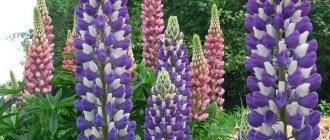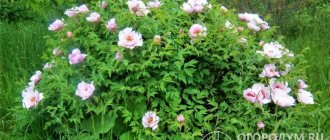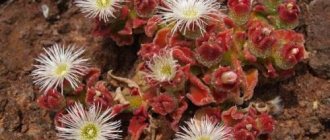Home » Flowers and plants » Outdoor plants » ? Perennials
Olga Polyakova 03/24/2020
14111 Views
Verbena is a member of the genus and family of plants of the same name, widely distributed throughout the globe. It is impossible to give a definite answer as to where the plant came from.
Its various species have natural habitats on all continents of our planet. Most of the 124 described species come from South America. And although verbena has a good appearance, the plant has gained popularity due to its aroma.
The essential oils contained in the plant make it a welcome guest in any area. Planting and caring for verbena is quite simple and does not require any specific knowledge. Under natural conditions, most verbena species are able to survive without any human help, reproducing by self-sowing.
Description of hybrid verbena
Hybrid verbena (Verbena hybrida) is a low plant with a fibrous root system and branched spreading stems. It has oblong, pubescent leaves of a dark green hue, heart-shaped in the lower part of the bush; the plates are located opposite on the shoots.
Hybrid verbena flowers bloom in early summer and appear until frost. Depending on the variety, the petals have a white, pink, purple or red tint. The buds are collected in 30-50 pieces into round panicles located at the tops of the shoots. They can be either single-color or two-color - with a light or contrasting eye in the core.
During flowering, hybrid verbena exudes a pleasant aroma that intensifies in the evening.
Verbena hybrid height
The height of a perennial plant depends on the variety. Some varieties of verbena stretch up to 60 cm, others rise only up to 15 cm above the ground.
Sowing time
To grow annual verbena, the seedling method is used. This is due to the length of the period from sowing to flowering, which is 70-100 days, in some varieties it reaches 120 days. The packaging of seeds from responsible producers always indicates the recommended sowing time.
Regions
When determining the sowing time, you should start from the planned time of planting verbena seedlings outside, since it does not tolerate frost. In different regions, warm weather without dropping to sub-zero temperatures at night comes at different times. This should serve as a key point when calculating sowing dates.
Sowing time:
- Central region – March;
- Northwestern region – early – mid-April;
- Ural, Siberia - April;
- Central Black Earth and North Caucasus regions - late February - mid-March.
Moon calendar
Climate features make it possible to determine the period of sowing in different regions. Specific sowing dates are helped by choosing the lunar calendar, which determines favorable and unsuitable days in the desired month.
You should not sow on the days of the full moon and new moon. The most productive days for sowing are the days during the waxing Moon, but during the waning Moon you can also carry out sowing work.
Varieties of hybrid verbena
Hybrid verbena is very popular among gardeners. Breeders have developed many varieties that differ in flowering time, bud shade and bush height.
Quartz Blue
Compact hybrid verbena reaches 25 cm above the ground and grows up to 30 cm wide. It bears purple buds with a white core and remains decorative from June to October. The diameter of the inflorescences of the variety is about 7 cm.
Quartz Blue can be grown in soil and in pots
Quartz Scarlet
Early-blooming miniature verbena produces rich scarlet buds with lilac or white eyes. It blooms in mid-summer and fades only in October. It grows to about 20 cm, spreading 30 cm in diameter.
Inflorescences of the Quartz Scarlet variety reach an average of 5 cm in width
Etna
Bright red hybrid verbena rises up to 45 cm above the ground. The inflorescences of the variety are dense, umbrella-shaped, up to 7 cm wide. Each consists of an average of 40-50 buds with a creamy white eye in the middle.
The Etna variety may fade slightly in the sun
Magenta
A low hybrid variety with a height of up to 20 cm produces crimson buds with a white eye. The flowers are collected in dense spherical umbrellas; the decorative effect is emphasized by openwork leaves. The hybrid blooms from June to October.
The Magenta variety has a delicate aroma and is suitable for cutting
Silver Anne
A hybrid variety with fragrant soft pink flowers blooms in early summer. During the decorative period it emits a pleasant smell. The height rises to an average of 25 cm.
The Silver Ann variety wilts only by November
Schneekenigin
A hybrid variety up to 55 cm above ground level begins flowering in mid-summer. Brings snow-white buds with a light green eye. The flowers are collected in dense umbels up to 6 cm wide.
The diameter of individual Schneekenigin buds is about 2 cm
Defiance
The low variety blooms at standard times in early summer and remains decorative until late autumn. The height of the bushes is a maximum of 30 cm. The flowers of verbena are bright red, up to 2.5 cm wide, with a greenish eye visible in the center.
The inflorescences of the hybrid variety Defiance reach 5 cm in width
Pink Parfait
An interesting variety up to 30 cm in height forms long creeping shoots. Suitable for growing in hanging pots. The buds of the variety are pink with a cherry tint and a dark eye.
The Pink Parfait variety is best planted in partial shade to avoid burnout
Adonis Mango
Verbena forms loose, low bushes and has highly branching shoots. At the beginning of the decorative period, the buds of the variety are orange-red or apricot, then become honey-yellow and finally fade to a creamy hue.
The height of Adonis Mango verbena is about 30 cm
Peaches and Cream
Hybrid verbena is suitable for growing in open ground and flowerpots; it grows up to 40 cm. It produces spike-shaped inflorescences with numerous apricot, pinkish and beige buds.
The Peaches and Cream variety blooms in July and will remain decorative until the end of September Obsession Bordeaux
A compact variety up to 20 cm tall, spreading widely in diameter up to 50 cm or more. Suitable for flowerpots and open ground, it has numerous branched shoots. The color of the buds is burgundy with white eyes.
The Obsession Bordeaux variety has particularly good immunity to fungi
Tuscany Lavender Picotee
The hybrid variety produces bicolor buds with lilac-pink petals and a white center. It is compact and has a pleasant aroma; the bushes bloom at about the same time.
Tuscani Lavender Pikoti rises up to 25 cm above the ground
Popular varieties with photos
There are more than 200 plant species in nature. Among them are those that are used in folk medicine and that decorate the garden. Verbena can withstand temperatures up to +3°C, so it takes root well in the southern regions of Russia, where winters are quite mild.
In harsh conditions, the flower is grown as an annual in the garden or a perennial in a pot at home.
Here are the most popular types and varieties of verbena:
- Hybrid.
- Bonarskaya.
- Peaches and cream.
- Finely dissected.
- Rumba.
- Garnet star.
- Ideal.
- Lady dream.
- Ampelous undersized.
- Large-flowered.
- Melody.
- Charming eyes.
- Imagination.
Reproduction methods
Hybrid verbena (Verbena Hybrida) responds well to propagation by vegetative methods. Two methods are usually used:
- Cuttings. In August or September, shoots up to 8 cm long are cut from the tops or from the middle from a healthy bush. The cuttings are placed in water with the addition of Kornevin or in a substrate of peat and sand. Before rooting, the shoots are kept in a mini-greenhouse under film or glass; after new shoots appear, the tops are pinched. The cuttings are transplanted to a permanent place in the spring in the second half of May.
- Division. An adult plant is dug out of the ground and cut into 2-3 parts along the rhizome, after which the bushes are planted in separate holes. The method is used quite rarely, since hybrid verbena is usually bred as an annual.
The culture takes root quite quickly after vegetative propagation, taking root on average within a couple of weeks.
Use in garden design
Ampel verbena - growing in a pot, planting and care
Creeping, hanging varieties are mainly grown in pots and used to decorate balconies, loggias, and terraces. Upright bush varieties are planted in open ground.
Note! The best companions in flower beds for hybrid verbena are cineraria, pelargoniums, and petunias.
Pots with pelargoniums, verbenas and petunias
The planting site is chosen in bright sun. Only in this case will the plant be able to demonstrate the full potential of its inflorescences. In the shade the flowers become smaller.
Decorate the garden with verbena, choosing the optimal placement for each variety:
- dwarf flowers are planted along borders;
- compact medium-sized bushes are placed in arrays, as well as in flowerpots and flower pots;
- hanging varieties are planted in hanging balcony boxes and are also used in vertical gardening;
- All varieties need protection from the wind, because of which tall bushes can fall to the ground, and dwarf and ampelous ones lose their decorative effect.
Important! Cutting throughout the summer is carried out only from bushy tall verbenas, but regardless of the specific variety, the bouquets last in vases for only 2-3 days, and then they wither.
Growing hybrid verbena from seeds at home
Photos about growing hybrid verbena from seeds show that the method is not associated with great difficulties and is often used for propagating the crop. In the process, only basic rules need to be followed.
Terms and conditions of cultivation
Sowing hybrid verbena for seedlings is usually carried out at the end of February or at the beginning of March. For seeds, select a wooden or plastic container with low sides. It is necessary to make drainage holes at the bottom in advance. The soil is prepared light and nutritious; you can mix peat, garden soil and sand in a ratio of 4:2:1.
Attention! To increase looseness, it is recommended to add 200 g of wood ash and about 500 g of perlite per 4 liters of substrate.
Both the container and the soil mixture are treated with a light pink manganese solution or scalded with boiling water. This helps avoid the development of viruses and fungal diseases.
How to plant correctly
Planting hybrid verbena on seedlings is carried out according to a simple algorithm. The diagram looks like this:
- The seeds are pre-soaked in a solution of Zircon or Epin for 20 minutes.
- The container is filled with substrate and watered generously with warm water.
- The prepared seeds are laid out on the surface of the soil at a distance of 2 cm from each other.
- Sprinkle the material with soil in a thin layer of up to 2 mm.
- Moisten the soil again with a spray bottle.
- Stretch the film over the container.
At first, the seedlings are kept in a shaded place at a temperature of about 25 degrees and ventilated daily. After the seedlings have formed, the shelter is removed and the box is moved to a well-lit windowsill. It is advisable to reduce the temperature to approximately 20 °C.
After planting with seeds, hybrid verbena shoots should appear in 3-7 days
Caring for seedlings comes down to periodic spraying and additional illumination of the sprouts for up to 14 hours a day. After the first leaves appear, the verbena is planted in separate containers. About a couple of weeks before transferring the seedlings to open soil, they begin to harden them in the fresh air so that the temperature change does not turn out to be too sharp.
Aftercare
In the middle or at the end of May, hybrid verbena seedlings are transferred to the ground. A place for the culture is selected that is well lit, but protected from drafts and strong winds. The soil is required to be fertile and loose, neutral in composition.
Caring for hybrid verbena after planting in open ground consists of several activities:
- Watering. It is necessary to moisten the ornamental crop 1-2 times a week, depending on the condition of the soil.
- Feeding. At the end of spring, hybrid verbena is fertilized with organic matter, and complex minerals are added at the beginning of bud formation. In mid-summer, the crop needs to be fed with phosphorus and potassium.
- Weeding. Simultaneously with watering hybrid verbena or after rains, it is necessary to loosen the soil. This improves air access to the roots of the plant. It is also recommended during the loosening process to remove weeds that take away nutrients and moisture from the crop.
- Trimming. During the decorative period, it is necessary to promptly remove dry panicles of verbena, shortening the stem by 1/4 of the total length. This stimulates the growth of new shoots and allows flowering to prolong.
Hybrid verbena can overwinter in open ground only in the southern regions, since the frost resistance of the crop is low - up to -2 ° C. With the onset of autumn, the bush is cut almost flush with the ground and insulated with spruce branches.
Attention! In temperate climates, verbena is grown as an annual plant and replanted from seeds or cuttings each spring.
How and when to plant verbena seedlings
You can determine the appropriate timing for picking seedlings by looking at the seedlings - the first pair of true leaves should appear on them . This moment occurs about a month after planting the verbena seeds.
The composition of the soil for picking changes slightly : now you should mix soil from the garden (2 parts) + peat (2 parts) + sand (0.5 parts). It is also recommended to pre -fertilize the soil , since at this stage of cultivation more fertile soil is needed. To do this, add a glass of ash and a tablespoon of complex fertilizer to 6 liters of soil. It is necessary to add perlite for better soil structure.
The container for picking seedlings can be either general (wide boxes) or individual (cups, pots, cassettes). Single containers must have a diameter of at least 5 centimeters.
Verbena seedlings should be planted according to this scheme:
- 2 hours before the event, water the container with the plants.
- Fill the containers with soil, first placing a drainage layer on the bottom, and level the surface of the soil.
- Water the planting container and make a small hole (if you are planting in a common box, then there should be a gap of 5 centimeters between the holes).
- Now you need to carefully remove the seedling along with a lump of earth and plant it in a hole up to the cotyledon leaves.
- Lightly compact the soil and water.
Key points of post-picking care:
- After the procedure, you need to move the plants to the brightest and sunniest place.
- If the soil settles over time, it needs to be added to the container.
- If you have an ampelous variety, then you need to pinch the top of the seedlings when six true leaves grow. Pinching promotes intensive growth of shoots and makes the bush more lush.
- The first fertilizing is done a week after picking; a mineral fertilizer containing nitrogen is suitable. And then every two weeks you can use mineral complex fertilizers that contain nitrogen, potassium and phosphorus, but the nitrogen content should be slightly lower (for example, Ammofoska).
Diseases and pests
Hybrid verbena is susceptible to many fungal diseases. Most often the culture is affected by:
- root rot - verbena leaves and stems turn yellow and wither;
Root rot develops against the background of waterlogging of the soil - powdery mildew - a dry whitish coating appears on the plates and inflorescences;
Spraying with copper preparations helps get rid of powdery mildew in the first stages.
The best prevention of fungal diseases of verbena is quality care. It is necessary to follow the rules of growing crops, avoid waterlogging and drought, and carry out timely fertilizing. When symptoms of disease appear, it is necessary not only to spray the bush with fungicidal agents, but also to cut off all affected parts. Plants that are too severely affected are completely removed from the flowerbed. The remains of diseased bushes are taken out of the flowerbed and burned in the far corner of the garden.
Of the pests, the greatest danger to verbena is:
- spider mite - the insect settles on the underside of leaves and feeds on the juices of the crop;
You can recognize the presence of a mite by the light webbing between the verbena stems. - aphid - a parasite appears in early summer, eats verbena greens, causing deformation of the plates and buds.
Aphids attack verbena in large colonies and can quickly destroy the plant.
If there are few pests on the crop, they are controlled using a soap solution. For serious lesions, chemical agents are used - Actellik, Aktaru and similar ones. Following agricultural practices also helps prevent parasite attacks. Pests more often attack verbena in conditions of waterlogging or when planting too densely.
Care after landing
After planting, sprouts appear within 7-10 days. Then you need to move the seedlings to a cooler place with a temperature of +15...17°C. She will need a lot of light.
The film or lid must be lifted to allow the seedlings to breathe, and excess moisture must be removed. If necessary, moisten the soil with a spray bottle.
When the first leaves grow, the film needs to be removed. When they appear, the sprouts need to be separated from each other if they were in a common pot. 14 days after depositing, it is necessary to fertilize with complex mineral fertilizer.
What plants does it go with?
Verbena can be planted alone or combined with other crops on the site. The best neighbors for the plant are:
- ornamental cereals;
- marigolds and asters;
- sage and echinacea;
- petunia and bronze fennel;
- heliotrope and cineraria.
When creating an artistic composition, it is necessary to ensure that the plants have the same requirements for conditions and care. It is recommended to use hybrid verbena to create flower beds and low borders.
Hybrid verbena is usually short in stature, so it is planted in the foreground of flower beds
Preserving verbena in the house in winter
Hybrid verbena can overwinter at home so that when warmer weather arrives, the gardener can plant it again in its original place in an outdoor flowerpot or flower garden. The plant does not tolerate frost or even light frost. Therefore, work with it is carried out in advance, without waiting for really cold nights.
Pot of blooming verbena on the windowsill
In autumn (September), all damaged, broken and withered shoots and inflorescences are cut off from the bush. The bush is dug up and moved to a pot of a suitable size. Then they are transferred to a bright room, where a stable temperature of 4-7 °C is maintained throughout the cold season. Periodically it is necessary to moisten the earthen ball, preventing it from completely drying out.
Important! Keeping the plant warm in winter is only possible with regular feeding and additional lighting, creating a daylight duration of 10-12 hours.
Conditions for crops
The most important conditions for the germination of verbena seeds are temperature and moisture. The optimal temperature is +25°C, so it is important to place the container in a warm and well-lit place.
Although moisture is necessary for germination, condensation should be avoided and 15-20 minutes daily. ventilate microgreenhouses.
Sowing work - step-by-step instructions
Sowing verbena seeds for seedlings consists of a number of simple sequential operations, and does not cause difficulties even for novice gardeners.
- Fill pre-prepared containers with soil mixture. It is better to prepare a separate container for each variety.
- Level the soil, lightly compact it and moisten it with a spray bottle.
- Distribute the treated and stratified seeds evenly on the soil surface. Lightly sprinkle with soil or peat.
- Moisten the sown seeds a little using a fine spray.
- Cover the container with seeds with film, a plastic lid or glass.
When planting, follow the recommendations of the seed manufacturer: there are varieties that germinate when exposed to light and do not require sprinkling with soil.
Verbena care
Caring for verbena is quite simple. During the growing season and flowering, it must be watered systematically. From mid-July, a gradual reduction in watering is carried out. It is necessary to loosen the surface of the area only in hot weather after it has been watered abundantly. This will help improve the drainage properties of the soil so that air can flow to the roots.
When planting verbena in groups, it will only need weeding for the first time. Overgrown bushes, as a rule, crush the weeds. When planting alone, weeding will have to be done regularly. If, after planting the seedlings, you cover the surface of the earth with a layer of mulch, then the need for weeding and loosening the soil will disappear.
Top dressing
Verbena can be fed with both organic and mineral fertilizers. The application of organic fertilizers to the soil is carried out only once during the season, otherwise a large amount of nitrogen may accumulate in the soil, which is why flowering becomes sparse, but the foliage is lush. The plant is fed with the mineral complex 3 or 4 times during the season.
Bloom
With proper and timely feeding of the crop, it will certainly delight you with lush and spectacular flowering. The main thing to remember is that fertilizers should contain a small amount of nitrogen. Verbena flowers are very beautiful and have a delicate, pleasant scent. Do not forget to pick off faded inflorescences in time, then the bushes will bloom luxuriantly until late autumn.
Pests and diseases
This culture is highly resistant to diseases. If you care for it correctly, it will not cause any trouble. However, if watered excessively or during hot, rainy months, the plant may develop powdery mildew. Sick bushes are treated with sulfur, saprol or Fundazol. It is also quite rare for aphids or mites to settle on verbena, which can be gotten rid of with the help of insecticidal preparations.
Excessively abundant and frequent watering can cause the flower to become damaged by black stem, various spots and rots. In this regard, it needs to be watered correctly, then it will not have to deal with pathogenic fungi and nematodes, which are the cause of the development of diseases.
Verbena: cultivation and care
Brief description of the plant
Verbena (Verbena L.) is a botanical genus of about 250 plant species, native to America. In Europe, 2 species are found in nature, but the most popular species in cultivation is common verbena (V. officinalis). Buenos Aires verbena (V. bonariensis) is also popular. Currently, decorative hybrid forms have been developed, known as garden or hybrid verbena (V. hybrid).
Verbena is a perennial, but in our climate, due to its heat-loving nature and lack of frost resistance, it is grown as an annual herbaceous plant. Buenos Aires verbenas reach 180 cm in height and grow up to 90 cm to the sides. Their stems are sparsely covered with leaves, so they do not obscure the plants located behind them, but only add a pleasant color accent in the form of delicate, but extremely numerous purple flowers.
The leaves are lanceolate with serrated edges. The plant impresses with its tenderness, does not need support, and does not disturb the symmetry of the garden. Complements tall grasses and low flowers.
Garden verbena varieties are divided into 2 groups:
- low (Compact) - reach a maximum of 30 cm, have straight shoots;
- tall (Grandiflora) - grows 50 cm; ampelous verbena has hanging shoots.
The flowers of garden varieties are large, five-lobed, and form capitate inflorescences.
The flower petals of this species vary in color - uniform and multi-colored, including white, yellow, pink, red and purple.
In nature, Verbena officinalis can be found on rocky, dry slopes, roadsides, and wastelands.
Adviсe
- To speed up the germination of sown seeds, it is recommended to put them in the refrigerator for a period of 2 to 3 days. For the same purpose, you can use a growth stimulator by soaking the seeds in the solution before sowing.
- With proper care, verbena is not prone to disease, but excessive watering can lead to rotting of individual parts of the plant and the appearance of diseases such as powdery mildew or blackleg. Regular watering is required only during the growth and flowering period, then it is reduced. Remember that watering should always be moderate. But the soil should not be allowed to dry out.
- To extend the flowering period of verbena, do not forget to remove faded inflorescences. You need to cut about a quarter of the length of the shoot. It is also necessary to regularly loosen the soil around the plant (especially during dry summers after watering), and remove weeds from single bushes.
Using the recommendations for growing verbena given in this article, you can independently and easily decorate your garden with this beautiful, unpretentious and long-flowering plant.
If you find an error, please select a piece of text and press Ctrl+Enter.











